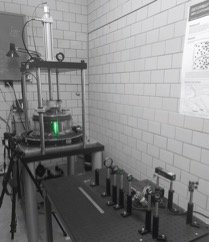Earthquakes or slow-slip? How we use laboratory experiments to link material properties to slip dynamics - Jacqueline Reber, Iowa State University
Jacqueline Reber, Associate Professor in the Department of Geological and Atmospheric Science at Iowa State University.

Abstract: Constraining the rheology of the lithosphere is of fundamental importance for understanding plate tectonics as well as earthquake generation. This task, however, is exceedingly difficult as a variety of deformation mechanisms contribute to the integrated strength of the lithosphere. Rocks at high-pressure and high-temperature conditions flow viscously by a number of deformation mechanisms whereas at low-pressure and low- temperature conditions rocks crack, fracture, lose cohesion and slide frictionally. At intermediate crustal depth, deformation is hence achieved by a complex spatial and temporal interplay between “viscous” and “brittle” processes. The interaction between these end-member cases where viscous flow cannot accommodate all the imposed displacement and abundant pervasive fracturing occurs leads to “semi-brittle” deformation. Semi-brittle deformation links the time scales associated with fracturing and earthquakes with the time scales associated with a flowing viscous crust leading to a mixture of stick-slip and creep. The co-occurrence of brittle and viscous deformation in rocks can be observed in the field over many length scales and in various lithologies.
A field examples of semi-brittle deformation will serve as starting points to investigate how forces are distributed between the brittle and viscous phases, how deformation localizes, and how the two phases impact the deformation dynamics. By combining field observations with physical and numerical experiments, deformation evolution can be observed and documented, length scales from micro to the macro scale can be investigated, and resulting deformation dynamics do not need to be preassigned, but can emerge from the material interactions. By employing various experimental materials, we can quantify the impact of the strength contrast between the brittle and viscous phases, the distribution between the phases, as well as the role of fracture formation and geometries on slip dynamics. The results show that semi-brittle rheology significantly impacts deformation dynamics, deformation localization, and the force distribution within the different material phases. All these aspects have a direct impact on the stability of fault zones and how deformation will manifest itself.
About: Jacqueline Reber is a structural geologist interested in the interaction and coexistence of brittle and ductile structures in rocks. To investigate the impact of complex rheologies on the formation of such structures, Jacqueline uses a combination of physical modeling, numerical modeling, and field work. In the structural experiment lab at Iowa State University, Jacqueline uses a wide variety of analog materials ranging from silicone and sand to polymers to simulate the behavior of rock in different deformation regimes. Jacqueline combines the lab results with field observations and numerical models to investigate the physical processes leading to stunning and complex deformation patterns in nature.
